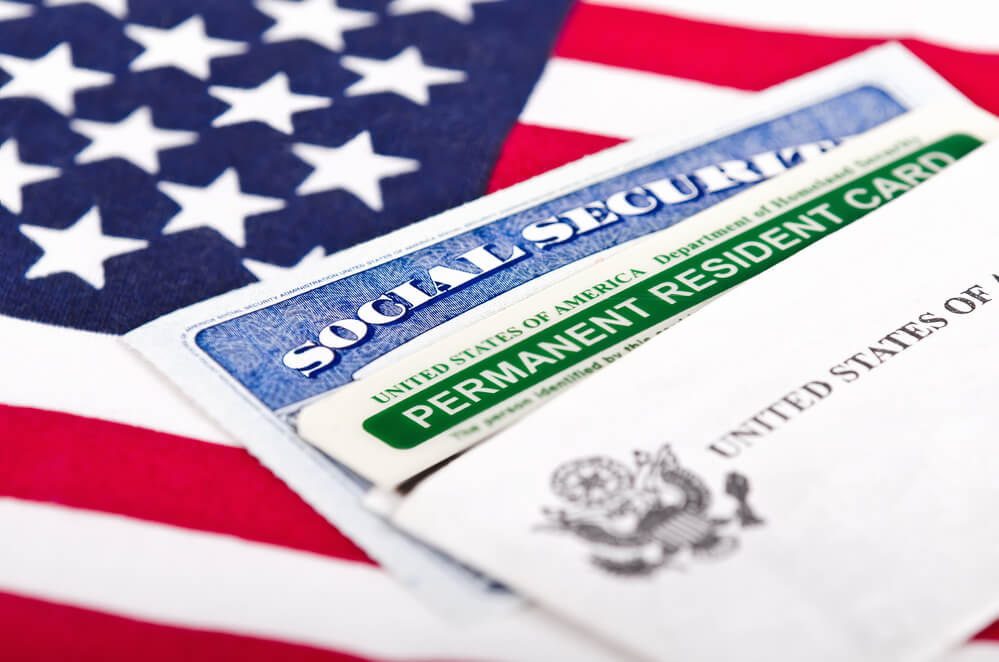How can a green card holder move a family to America
The owner of the green card, along with the opportunity to live and work permanently in the United States, receives the right to reunite with his family. If he has children, spouse or spouse in his homeland, he can take them to America. However, this process is quite long. ForumDaily found out how long it lasts and how it goes.

Фото: Depositphotos
Family bonds
Russian woman Maria Meshkova has been waiting for a decision to reunite with her husband Ruslan, a green card holder, for almost two years. She met her future husband via the Internet at the beginning of 2012. In November of the same year, he flew from the United States to Yekaterinburg, where Mary lived, and made an offer. The wedding was appointed by young people on June 2013. Sign decided in Russia.
“We were in no hurry with the documents for the green card, we were puzzled by the wedding arrangements and thought that it would be very easy to get a residence permit for me. It turned out not,” admits Maria.
At first, the couple wanted to get a tourist visa for Maria to go on a honeymoon to the United States. “In February, we applied for a visa: we collected all the financial information, bought tickets, booked a hotel, booked a cruise. But I was denied a visa,” says Maria. Trying to get a tourist visa while you are marrying an American resident is like an alarm signal for consulate workers. The applicant in such cases is always suspected of wanting to immigrate to the United States illegally.
Therefore, after the wedding, Ruslan returned to the United States alone and immediately through a lawyer filed for reunification with his wife. Maria stayed in Yekaterinburg. An interview at the consulate to receive a green card was assigned to her on 2015 May. Maria went there with Ruslan.
“We submitted everything at the interview: a lot of photos from joint travels, tickets, hotel reservations, receipts for rings, suits, renting limousines for a wedding,” says Ruslan. “But they only asked us about how we met and what my wife plans to do in the USA. The entire interview lasted five minutes.”
Four days later, she received a passport with an immigration visa and immediately flew to the United States. She herself waited for the green card only in December.
Green corridor
Only spouses and unmarried/unmarried children can count on reunification with their Green Card relative. Moreover, they are divided into different priority categories, which are spelled out in the main law governing immigration actions - the Immigration and Nationality Act. Accordingly, the higher the priority, the greater the chances of getting a green card faster. There are four levels in total that relatives of green card holders or US citizens fall under:
First: F1 - unmarried sons and daughters of US citizens
Second: F2A - spouses and unmarried children of green card holders under 21 years of age
F2B - unmarried children of green card holders over 21 years of age
Third: F3 - married sons and daughters of US citizens
Fourth: F4 - siblings of adult US citizens
An immigration lawyer, Anne Moreas, who has her own law office, explains: “For each category a certain number of visas is allocated each year. Most often, there are more applicants than visas. Therefore, a snowball effect appears: those who did not have time to receive this year are transferred to the next. Few visas are issued for children and spouses of green card holders. ”

Anna Moreas has been involved in immigration issues for over 10 years. Photos from the personal archive.
So according to State Department data, in 2016, just over 114 thousands of visas were issued for family reunification with a green card holder.
According to Anna Moreas, the spouses of green card holders and their children have been waiting for an immigrant visa until the year 21, usually for about a year and a half. Children older than 21 can wait for reunification before 7 years.
Many green card holders, therefore, try to first obtain citizenship, and then pick up close ones, because there are no quotas for the closest relatives of US citizens, and this significantly speeds up the process.
What documents to submit and how much it costs
The holder of a green card and relatives with whom he wants to apply for a residence permit must collect at least the following documents:
- Petition to a relative (form I-130) on behalf of the green card holder.
- Proof of permanent resident status (green card).
- Proof of kinship (birth certificate, marriage certificate, etc.).
- Proof of legal name change (for the recipient).
- After approval of the petition will need to provide confirmation of sponsorship - the form I-864 (Affidavit of support). It ensures that the green card holder can financially provide for his relative if necessary.
- If a relative is in the US at the time of issuing a green card, then he is served I-485 form - statement of the change of status (Adjustment of status).
However, the full list of documents will depend on the specific case and may be much broader.
For the submission and receipt of each of the documents there are state fees:
Form I-130 – $420
Affidavit of support – $120
Immigrant visa – $325
Green card – $165
Application for adjustment of status - $1070 per adult, $635 per child.
Even if the person himself is engaged in collecting documents and filing them, without the participation of lawyers, getting a green card for a relative along with passing a medical examination will cost around 1000-2500 dollars. The price may increase due to the services of lawyers and joint trips to the consulate.
Two ways to reunite
After filing a petition from a green card holder for family reunification, there are two main paths of events. They depend on where the relative is located. If he remains in his home country, then his case is considered at the US consulate at his place of residence. If he is waiting for a decision in America, then he goes through the procedure of changing his non-immigrant status (for example, he is here on a tourist, work or student visa) to an immigration one - the Adjustment of status we have already mentioned.
If a relative stays at home
In this case, getting a green card looks like this. The green card holder fills out an I-130 petition to his relative and sends it to the United States Citizenship and Immigration Services (USCIS). If approved, it is forwarded to the National Visa Center, and the applicant sends there all the remaining documents. When an immigrant visa becomes available, a relative who has been petitioned is interviewed at a US consulate in his home country and receives an immigrant visa. Upon arrival in America, he is issued a green card.
It is impossible to say exactly how long it will take for the petition to be approved by Citizenship and Immigration Services. The period depends on the workload of the offices reviewing documents. According to lawyer Anna Moreas, the service center in California with which she works takes about 8 months to review documents and sometimes requests additional documents. “After filing, Citizenship and Immigration Services receives a notification that the petition is in process,” notes Anna. — The date of acceptance of documents by the immigration service will be very important, because it will be considered the so-called Priority Date. This date determines the person’s place in their visa queue.”
You can track turn on visa bulletin website. Your date of receipt of documents should be compared with the one shown in the newsletter. You will learn that you can get an immigrant visa when they match. For example, in April 2016, the documents that petitioners submitted before 22 October 2014 for the F2A category and before 15 June 2009 for the F2B category are considered.

The national visa center monitors the queue and asks for the missing documents about six months before its approach. When a place in the queue for a visa is suitable, the National Visa Center reports this to the green card holder and his relative. In English, this is indicated by the phrase “visa number available” (visa number is available). Then the visa center agrees on the date of the interview between the applicants and the US consulate in the relative’s home country, where all the documents are sent. If the petition is approved, the documents are sent to US National Visa Center. “This is an intermediary between the immigration service and the consulate. It actually slows down the process,” says Anna Moreas. “It’s such a “black hole” - documents go in there, and who knows when they will come out.”
According to lawyer Anna Moreas, the consulate may request additional documents. In particular, in the case of obtaining a green card for marriage, it is necessary to prove that it is not fictitious.
List of additional documents to bring to the interview:
- Joint photos (from leisure, weddings, etc.).
- Documents on joint finances or property (for example, the purchase of real estate).
- Private correspondence.
- Logins from social networks (sometimes they check whether people really communicate or this acquaintance for the sake of fictitious marriage).
- Contacts of people who can confirm family ties (for example, friends and colleagues).
Lawyer Moreas warns that consular officials may refuse a visa or return documents to the US Citizenship and Immigration Services, suspecting that the petition was approved by mistake. Then you have to wait for its re-consideration. You may need additional documents. If the immigration service refuses to renegotiate, then it will already need to appeal. And in this case it is better to do with a lawyer.
Fathers and Sons
Ukrainian Victor B, who applied for a green card for his wife and daughter, just went through the process of obtaining documents through the consulate. There was one complicating factor in his case - at the time of the birth of his child, he was not formally married, but was listed on the birth certificate. In October 2011, he won a green card. After that, he signed with his common-law wife. She remained in Ukraine, he moved to the USA.
“We decided that first it would be better for me to settle in alone, and then call them,” Victor tells ForumDaily. “I filled out all the documents for family reunification myself, I didn’t turn to lawyers because it was too expensive for us. But we were in no rush, and the entire process from filing the petition to getting the immigrant visas approved took us two and a half years.”
It was not easy for Victor to figure out on his own the nuances of processing immigration documents. American friends and information from the forums helped.
“I submitted documents at the beginning of 2012. Then I was already working and attending ESL courses (English as a Second Language - Author). My English was still not very good, but I still found the information I needed right on US immigration site, says Victor. “It seems to me that in complicated cases it is worth seeking help from lawyers.”
He now lives with his family in Pittsburgh, Pennsylvania.
If a relative is in the US
If the relative who is receiving the green card is in the United States on any nonimmigrant visa, then the process looks different. The green card holder files a petition against the relative. If approved, you also need to wait your turn for a visa. The difference is that while waiting you do not need to leave America. The interview for a green card takes place in the United States. This process of changing status is called Adjustment of status.
It passes somewhat faster than through the consulate. According to lawyer Anna Moreas, people who change their status without going outside the United States have some advantage. The Immigration Service allows you to file a complete set of documents before an immigration visa becomes available. A petition for a green card is considered for 4-6 months.
In this process there are two main steps:
1) standard green card petition holder I-130 on her relative, her approval and waiting for an available visa number;
2) form submission I-485 — application for adjustment of status. All requested documents and evidence (for example, arrest or conviction records, divorces, etc.) must be attached. A mistake could cost you your green card.
After that, you need to pass biometric data.
At the interview in the office of immigration it is necessary to bring the originals of all documents. The Citizenship and Immigration Service decides on issuing a green card and sends documents by mail. It usually takes less than a month, but again the time depends on the workload of the specific office that is considering the application. On USCIS website You can check what stage your case is at.
Read also on ForumDaily:
Life in California has not met expectations: how I left Google and returned to Kiev
'I will still remain Russian in this country': how a journalist moved to the USA
How long do I need to wait for the green card for family reunification: data for January
How a divorce can affect immigration status
10 reasons for refusing a US visa: what to do next
Three features of life in the United States that infuriate immigrants
Which of the relatives can be transported to the US by a green card holder
Do you want more important and interesting news about life in the USA and immigration to America? — support us donate! Also subscribe to our page Facebook. Select the “Priority in display” option and read us first. Also, don't forget to subscribe to our РєР ° РЅР ° Р »РІ Telegram and Instagram- there is a lot of interesting things there. And join thousands of readers ForumDaily New York — there you will find a lot of interesting and positive information about life in the metropolis.













